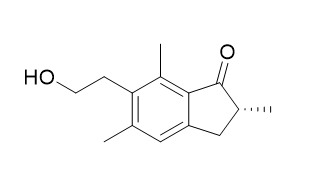Pterosin B
Pterosin B is a salt-inducible kinase 3 (Sik3) pathway inhibitor, it prevents chondrocyte hypertrophy and osteoarthritis in mice by inhibiting Sik3. Pterosin B shows cytotoxicity against HL 60 cells (human leukemia) with the IC(50) value of 8.7 microg/mL.
Pterosin B has multiple targets in gluconeogenic programs, including coenzyme Q in RORα-SRC2 signaling.
Inquire / Order:
manager@chemfaces.com
Technical Inquiries:
service@chemfaces.com
Tel:
+86-27-84237783
Fax:
+86-27-84254680
Address:
1 Building, No. 83, CheCheng Rd., Wuhan Economic and Technological Development Zone, Wuhan, Hubei 430056, PRC
Providing storage is as stated on the product vial and the vial is kept tightly sealed, the product can be stored for up to
24 months(2-8C).
Wherever possible, you should prepare and use solutions on the same day. However, if you need to make up stock solutions in advance, we recommend that you store the solution as aliquots in tightly sealed vials at -20C. Generally, these will be useable for up to two weeks. Before use, and prior to opening the vial we recommend that you allow your product to equilibrate to room temperature for at least 1 hour.
Need more advice on solubility, usage and handling? Please email to: service@chemfaces.com
The packaging of the product may have turned upside down during transportation, resulting in the natural compounds adhering to the neck or cap of the vial. take the vial out of its packaging and gently shake to let the compounds fall to the bottom of the vial. for liquid products, centrifuge at 200-500 RPM to gather the liquid at the bottom of the vial. try to avoid loss or contamination during handling.
Br J Pharmacol.2024, 181(24):5009-5027.
Current Topics in Nutraceutical Research2021, 19(1),p90-105.
Horticulturae2020, 6(4),76.
Neurochem Int.2020, 133:104629
ACS Pharmacol Transl Sci.2024, 7(2):395-405.
Processes2022, 10(10), 2008.
Nat Commun.2023, 14(1):5075.
Plant Physiol.2023, 193(3):1758-1771.
Pak J Pharm Sci.2023, 36(1):51-57.
Plants (Basel).2021, 10(5):951.
Related and Featured Products
Nat Commun. 2016 Mar 24;7:10959.
Pterosin B prevents chondrocyte hypertrophy and osteoarthritis in mice by inhibiting Sik3.[Pubmed:
27009967]
Osteoarthritis is a common debilitating joint disorder. Risk factors for osteoarthritis include age, which is associated with thinning of articular cartilage.
METHODS AND RESULTS:
Here we generate chondrocyte-specific salt-inducible kinase 3 (Sik3) conditional knockout mice that are resistant to osteoarthritis with thickened articular cartilage owing to a larger chondrocyte population. We also identify an edible Pteridium aquilinum compound, Pterosin B, as a Sik3 pathway inhibitor. We show that either Sik3 deletion or intraarticular injection of mice with Pterosin B inhibits chondrocyte hypertrophy and protects cartilage from osteoarthritis.
CONCLUSIONS:
Collectively, our results suggest Sik3 regulates the homeostasis of articular cartilage and is a target for the treatment of osteoarthritis, with Pterosin B as a candidate therapeutic.
Biochem Biophys Res Commun. 2016 Apr 29;473(2):415-20.
Pterosin B has multiple targets in gluconeogenic programs, including coenzyme Q in RORα-SRC2 signaling.[Pubmed:
26970301]
Hepatic gluconeogenic programs are regulated by a variety of signaling cascades. Glucagon-cAMP signaling is the main initiator of the gluconeogenic programs, including glucose-6-phosphatase catalytic subunit (G6pc) gene expression.
METHODS AND RESULTS:
Pterosin B, an ingredient in Pteridium aquilinum, inhibits salt-inducible kinase 3 signaling that represses cAMP-response element-binding protein regulated transcription coactivator 2, an inducer of gluconeogenic programs. As the results, Pterosin B promotes G6pc expression even in the absence of cAMP. In this work, however, we noticed that once cAMP signaling was initiated, Pterosin B became a strong repressor of G6pc expression. The search for associated transcription factors for Pterosin B actions revealed that retinoic acid receptor-related orphan receptor alpha-steroid receptor coactivator 2 (RORα-SRC2) complex on the G6pc promoter was the target. Meanwhile, Pterosin B impaired the oxidation-reduction cycle of coenzyme Q in mitochondrial oxidative phosphorylation (OXPHOS); and antimycin A, an inhibitor of coenzyme Q: cytochrome c-oxidoreductase (termed mitochondrial complex III), also mimicked Pterosin B actions on RORα-SRC2 signaling. Although other respiratory toxins (rotenone and oligomycin) also suppressed G6pc expression accompanied by lowered ATP levels following the activation of AMP-activated kinase, minimal or no effect of these other toxins on RORα-SRC2 activity was observed.
CONCLUSIONS:
These results suggested that individual components in OXPHOS differentially linked to different transcriptional machineries for hepatic gluconeogenic programs, and the RORα-SRC2 complex acted as a sensor for oxidation-reduction cycle of coenzyme Q and regulated G6Pc expression. This was a site disrupted by Pterosin B in gluconeogenic programs.
J Nat Med. 2008 Jul;62(3):358-9.
Isolation of 5-hydroxypyrrolidin-2-one and other constituents from the young fronds of Pteridium aquilinum.[Pubmed:
18437503 ]
METHODS AND RESULTS:
5-Hydroxypyrrolidin-2-one, along with (2R)-Pterosin B, shikimic acid, kaempferol-3-O-beta-D-glucopyranoside, transtiliroside, beta-sitosterol, daucosterol, glycerol 1-stearate and benzoic acid, were isolated from the young fronds of the bracken fern Pteridium aquilinum.
CONCLUSIONS:
5-Hydroxypyrrolidin-2-one, shikimic acid and glycerol 1-stearate were isolated from the plant for the first time.
Molecules. 2008 Feb 5;13(2):255-66.
New benzoyl glucosides and cytotoxic pterosin sesquiterpenes from Pteris ensiformis Burm.[Pubmed:
18305416]
METHODS AND RESULTS:
Three new compounds: 2R,3R-pterosin L 3-O-beta-D-glucopyranoside (1), beta-D-xylopyranosyl(1-->2)-7-O-benzoyl-beta-D-glucopyranoside (2) and 4-O-benzoyl-beta-D-xylo-pyranosyl(1-->2)-7-O-benzoyl-beta-D-glucopyranoside (3), together with nine known compounds, were isolated from the ethyl acetate extract of Pteris ensiformis. 5-[2-Hydroxyethylidene]-2(5H)-furanone (4), which had been synthesized, was isolated from natural sources for the first time. The structures of all isolated compounds were determined on the basis of mass and spectroscopic evidence.
CONCLUSIONS:
Compound 1 and Pterosin B (5) show cytotoxicity against HL 60 cells (human leukemia) with the IC(50) values of 3.7 and 8.7 microg/mL, respectively.



